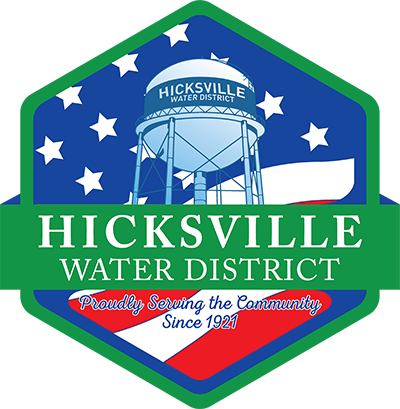Emerging Contaminant
Deferral Information
You may have seen the recent coverage regarding the Citizens Campaign for the Environment’s report on Long Island water providers that received a compliance deferral for the New York State’s new emerging contaminant regulations. Unfortunately for Long Islanders, this report is riddled with inaccuracies and grossly mis-represents our water quality as well as the great work the men and women of this industry continue to do to expedite the construction of state-of-the-art treatment systems.
The most egregious allegation of the report is that water providers with a deferral are serving residents water that is not in compliance with the new maximum contaminant levels. The Hicksville Water District has, like the vast majority of others that received a deferral, made operational changes to limit exposure, including taking impacted wells offline so residents receive water in compliance with the strict standards.
There is no priority greater to the Hicksville Water District than serving our community with the safest and highest quality water possible. We hope that you would agree that we have been transparent and forthcoming on this topic and keeping you adequately informed of our progress to improve our water systems.
We continue to provide monthly updates concerning the District’s deferral and all of the infrastructure projects currently in progress. We encourage anyone looking for information to check out these documents and feel free to contact us should they have any questions.
1,4-Dioxane Update
Our mission each and every day is to provide the residents of Hicksville with the highest quality water possible. In 2018, we started our deep dive into the process for implementing treatment for the removal of these emerging contaminants. So much progress has been made since and construction of treatment facilities for emerging contaminants at four of our plant sites is nearing completion.
1,4-Dioxane 2019-2020 Timeline
The process for implementing treatment for emerging contaminants is not simple. In fact, since the treatment technology–a combination of the Advanced Oxidation Process (AOP) and Granular Activated Carbon (GAC)–is so new, we have had to work closely with our health regulators to ensure the treatment systems work as expected and produce consistent results for years to come.
Here is a snapshot of the activities we have completed over the past year alone.
- July 2019: Pilot testing protocol for Plant No. 1 submitted to state and county health departments.
- August 2019: Pilot testing conducted at Plant No. 1.
- October 2019: Board of Commissioners pass an emergency resolution that authorizes our engineering team to design full-scale AOP treatment systems and empowers the District to directly engage equipment vendors and contractors for construction.
- November 2019: Pilot test report for Plant No. 1 submitted to state and county health departments.
- December 2019: Pilot testing protocol for Plant No. 4 submitted to state and county health departments; Pilot testing conducted at Plant No. 4.
- January 2020: Pilot test report for Plant No. 4 submitted to state and county health departments; Construction mobilization begins at Plant Nos. 1 and 4.
- February 2020: Engineering report for Plant No. 1 submitted to state and county health departments.
- March 2020: Engineering plans and specifications for Plant No. 1 submitted to state and county health departments.
- April 2020: Engineering report, plans and specifications for Plant No. 4 submitted to state and county health departments.
- June 2020: Pilot test report for Plant No. 4 accepted by county health department; County health department beginning review of engineering report.
- September 2020: Received final approval for Plant No. 4 to operate and produce water into the public distribution system.
Amidst the pandemic, the Hicksville Water District has continued to work diligently to outfit all our water treatment facilities with the most up-to-date filtration systems. The District’s construction is well underway and we are on track to have the facilities built before the anticipated compliance timeline.
About the Treatment

The only proven treatment method for removing 1,4-dioxane from drinking water is the Advanced Oxidation Process (AOP). AOP treatment blends raw groundwater with a low concentration of an oxidant—most commonly hydrogen peroxide—that then goes through a sophisticated ultraviolet light reactor that than destroys 1,4-dioxane molecules.
Once groundwater goes through the AOP process, that water is than piped into Granular Activated Carbon (GAC) vessels. GAC vessels—which are industrial-sized carbon filters—remove any remaining hydrogen peroxide and other volatile organic compounds (VOC) from the water. From here, water is chlorinated, tested and then goes into the distribution system.
Piloting, the design process, health department approval and the construction bidding process for the two approved AOP systems on Long Island has proven to take a significant amount of time. However, the Hicksville Water District has taken the appropriate actions to expedite treatment construction. This includes the passing of an emergency resolution to design and execute treatment.
Funding These Treatment Projects


Grants:
The District has been awarded more than $14 million in grant funding from the state to help offset the overall cost of these projects. While we are appreciative of their financial assistance, there is still an enormous budget gap given the amount of infrastructure needs to treat for emerging contaminants. We will continue to apply and seek out any and all forms for grant funding.
Bonding:
The District recently got a strong report from Moody’s Rating Agency meaning that we can borrow money at pretty much the lowest cost possible. Bonding for millions of dollars will be required in the near future to ensure we have the capital to continue with our construction projects. We will keep our residents informed throughout this process.
Litigation Against Polluters:
Since the water district nor our residents are responsible for the contamination being detected, we have been aggressively pursuing damages against polluters. While litigation can take years, our hope it to be successful in these lawsuits and use the compensation to fund our capital improvement budget and pay down any bonded debt.

PFOA and PFOS are not much of a concern for the Hicksville community at this time. Our sampling has shown that any detections are below the stringent regulations being set by the state. In the event levels should increase over time, the treatment we are constructing for 1,4-dioxane is cabable of removing these compounds.
Need More Information?
More Information on 1,4-Dioxane
We know that residents have questions related to health and safety. It is important to know that water providers are not health experts and we are not responsible, or qualified, for setting water quality standards on behalf of the public. Our function is to ensure that our water meets or exceeds the standards put in place by the qualified experts at our federal, state and local health departments.
If you have health-related questions, please contact the Nassau County Health Department at 516-227-9697 for more information.



